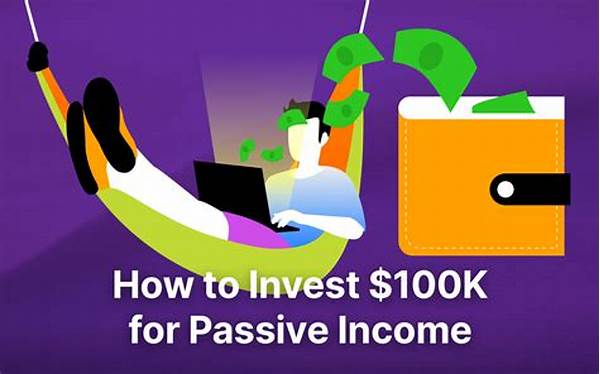
In the chase for financial freedom and stability, passive income is a phrase that dances on the tongues of many aspiring investors. Imagine lounging on a sun-kissed beach, cocktail in hand, while your bank account grows fatter by the minute—all thanks to the right passive income strategies. While it might sound like a dreamy infomercial promise, the truth is, with the right steps, you too can learn how to invest for passive income and enjoy its benefits. But before you start retiring your day job and buying one-way tickets to an island paradise, let’s delve into the sound strategies of making your money work for you effectively and efficiently.
Read More : Why Dividend Stocks Still Attract Young Investors
The concept of “how to invest for passive income” isn’t new, but in today’s rapidly changing economic climate, it’s more relevant than ever. With tools, resources, and financial products at our fingertips, anyone can begin plotting their path to a steady, flowless generation of income. One of the most appealing aspects of passive income is that it doesn’t demand your constant attention—your money works even when you don’t. Unlike a traditional job or active investment, passive income does not require a daily trading schedule or constant oversight. Instead, it thrives on initial smart decisions and calculated risks.
The layers of passive income vary: real estate rentals, dividend stocks, peer-to-peer lending, REITs, and even creating a blog or YouTube channel that earns ad revenue. Each comes with its set of requirements, pros, and cons. But the real magic happens when you diversify. A well-rounded passive income portfolio can be the key to harnessing your financial independence. But remember, while the initial setup might require effort, dedication, and in-depth research, the long-term benefits often skyrocket.
If passive income seems like the ultimate lifestyle choice, you’re not alone—many successful people have tapped into this mystical financial fountain.
1. Real Estate Investments: A timeless choice, property offers substantial returns through renting or flipping. It is crucial, however, to be aware of market trends, location desirability, and potential maintenance costs.
2. Dividend Stocks: Investing in dividend-paying stocks is a popular method for generating passive income. By reinvesting dividends, you can compound your returns over the long term.
3. Peer-to-Peer Lending: Platforms like Lending Club allow investors to lend directly to individual borrowers, usually at higher interest rates than traditional savings accounts.
4. Creating Digital Products: Whether it’s an online course, an eBook, or digital art, selling products on platforms like Gumroad or Etsy can generate passive income streams.
5. REITs (Real Estate Investment Trusts): These are companies that own or finance income-producing real estate across a range of property sectors, offering a way to invest in real estate without the complexity of direct ownership.
Understanding how to invest for passive income is not only about identifying opportunities but analyzing their potential sustainability. Let’s discuss how you can start your journey to generating passive income with calculated risks and effective strategies.
The allure of passive income is undeniable. We all seek that golden formula where investments yield profitable returns with minimal effort. However, diving into the passive income world unprepared is akin to entering a battlefield without armour. For starters, you should evaluate your risk tolerance, study market trends, and most importantly, educate yourself. It’s not just about throwing money at the next ‘big thing’ but rather understanding how each potential stream aligns with your financial goals and personal circumstances.
Before putting your hard-earned money into any venture, let’s tackle an essential facet—risk management. Calculated risks are the cornerstone of passive income strategies. Diversifying your investments helps mitigate potential pitfalls. It is critical to avoid putting all your eggs in one basket. Diversification spreads the risk across various investment vehicles, acting as a buffer when certain segments experience downturns.
Every passive income story is unique. Consider the entrepreneurial journey of Sarah, a school teacher who translated her passion for education into a successful online tutoring platform. Starting with a modest initial investment, her platform grew to support tutors worldwide, paid through a percentage of the profits. Today, her business offers her a steady income stream with minimal input—a testament to how a modest investment and leveraging existing skills can pave the way to sustained passive income.
For the budding investor, embarking on the journey to acquire passive income can seem daunting. Start small, learn with each step, and gradually build your confidence and portfolio. Let each experience, each investment decision, and each lesson learned through trial and error guide you. Remember, investing is not a sprint—it’s a marathon. With perseverance and informed decisions, you’ll soon find yourself reaping the fruits of your labor.
Creating the First Steps
Embarking on a passive income venture may feel like a leap into the unknown, but armed with the right knowledge and tools, anyone can succeed. Start by setting realistic expectations and create a roadmap outlining your short-term and long-term goals. Then, explore various passive income streams and weigh their pros and cons. Attending workshops, reading investment blogs, or even hiring a financial advisor can provide valuable insights.
Finally, always remember the golden rule of investing for passive income: never invest money you can’t afford to lose. Each investment, regardless of how secure it seems, carries a degree of risk. Approach the world of passive income with an open mind and a willingness to learn, and soon enough, you’ll see the rewards of your smart investments.
By strategically investing for passive income, you pave a path toward financial freedom. Remember, the goal is to make your money work for you, giving you more time to enjoy life’s precious moments. With diligence and smart strategies in place, financial independence is no longer a distant dream but an achievable reality.


